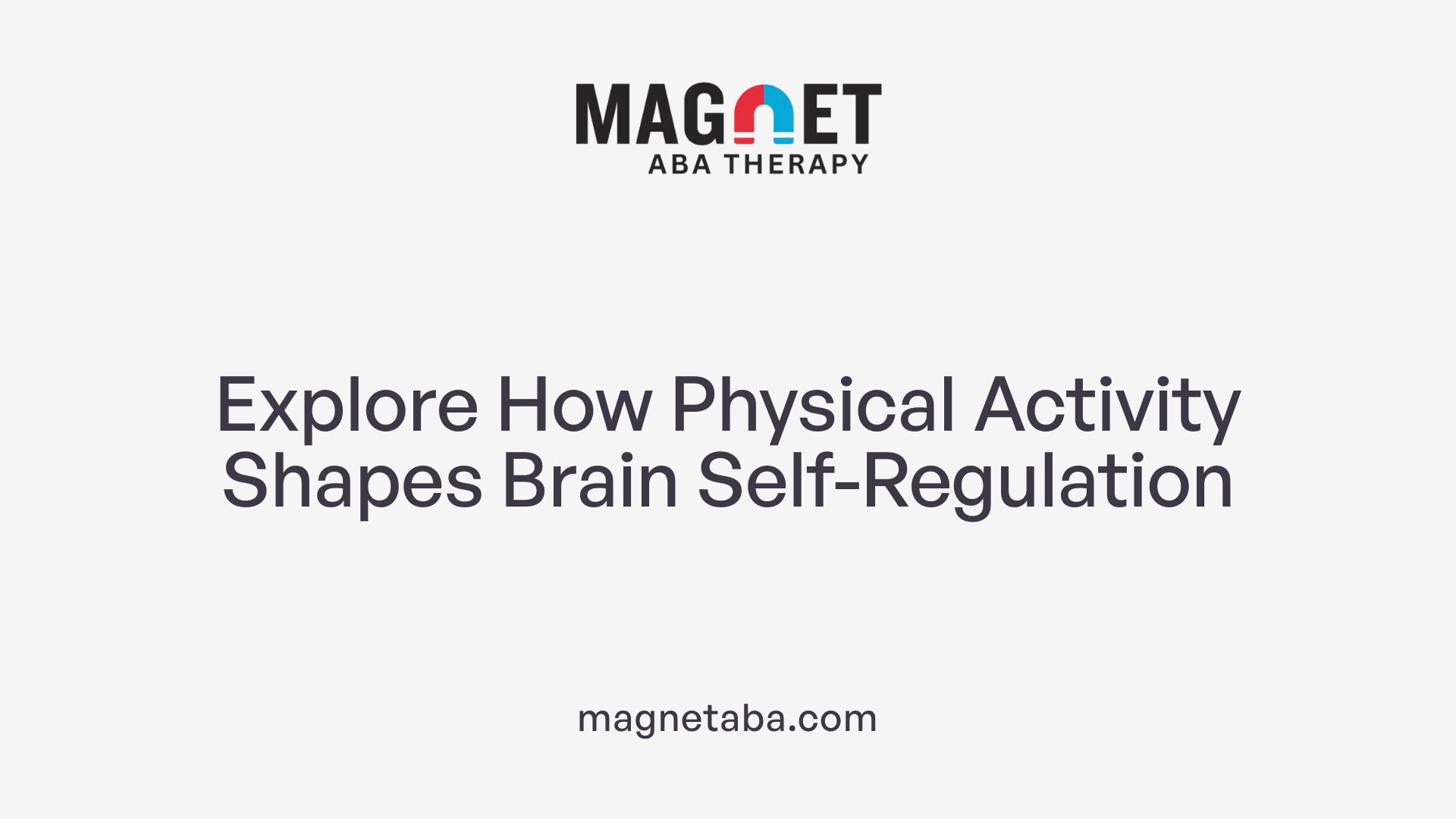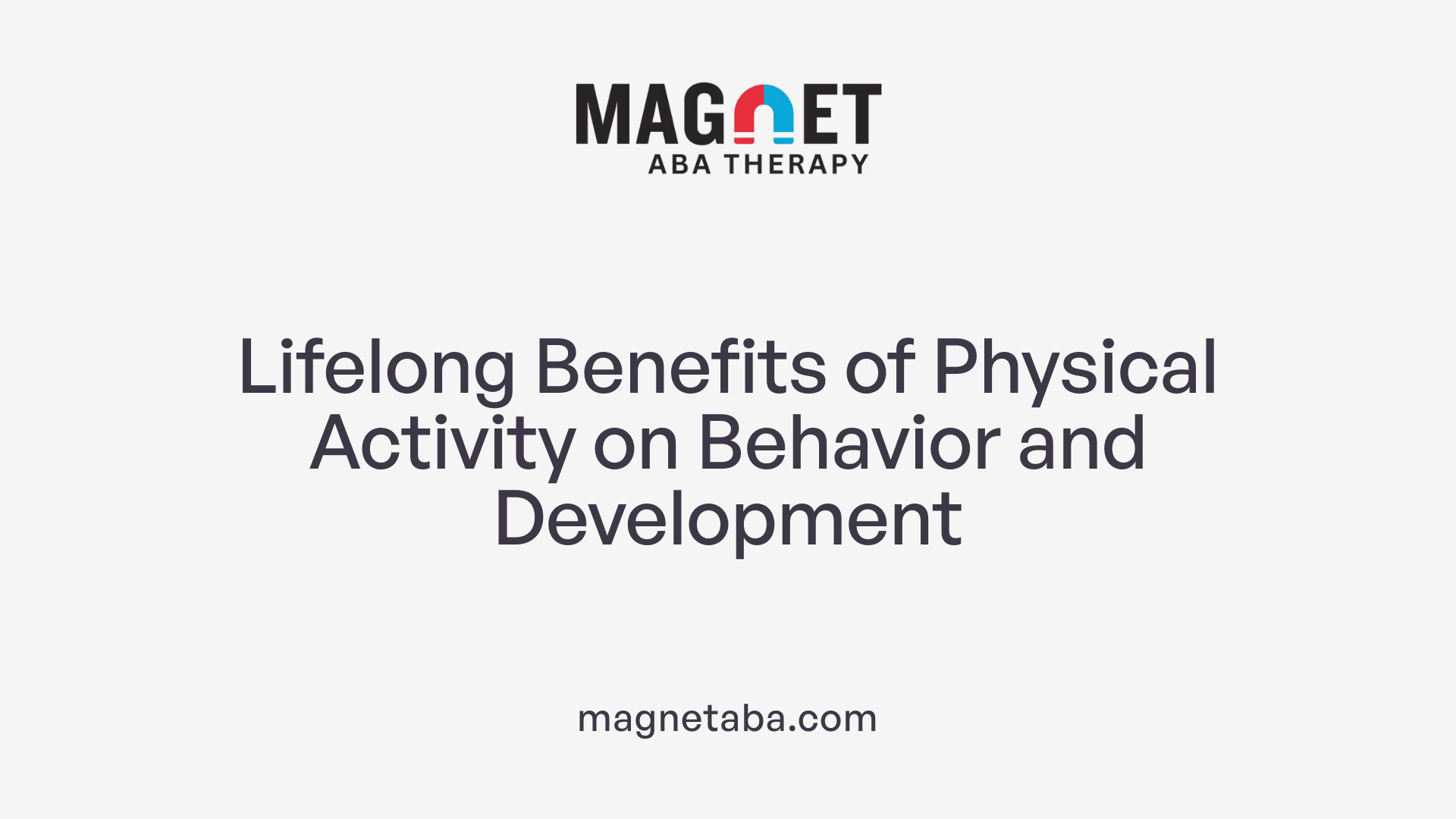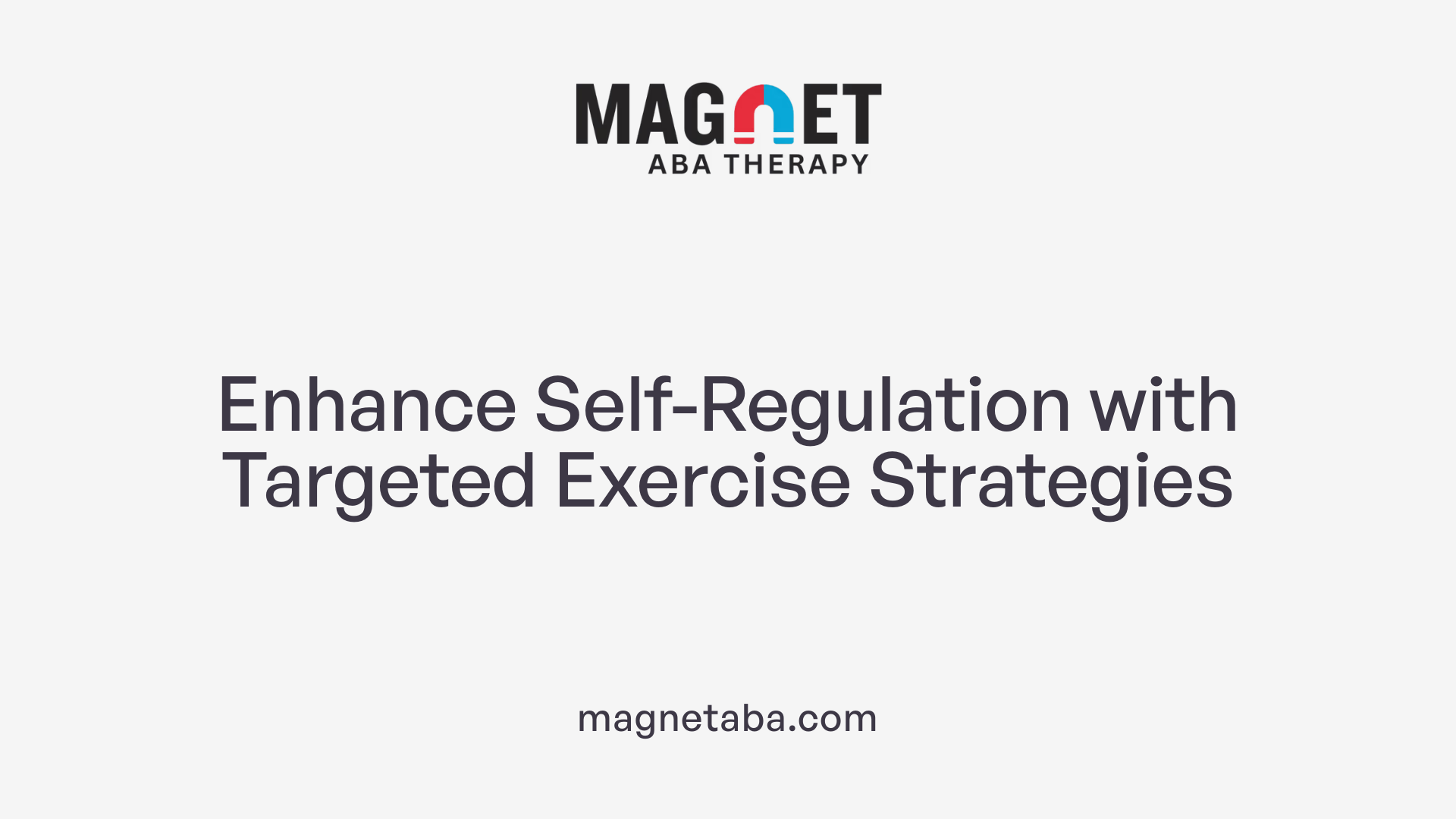Understanding the Multifaceted Impact of Physical Activity on Behavior Regulation
Physical activity (PA) plays a crucial role in shaping behavior, enhancing cognitive functions, and improving emotional well-being across all stages of life. This article delves into the neurological, psychological, and social mechanisms through which movement influences behavior regulation, highlighting evidence-based insights and innovative approaches for integrating physical activity into health and education strategies.
The Psychological and Cognitive Benefits of Physical Activity
How does physical activity influence behavior and cognitive functions?
Engaging in regular physical activity plays a crucial role in shaping both behavior and brain functions. It supports improvements in memory, learning, and problem-solving skills, which are vital for academic achievement and daily life. Physical activity enhances emotional regulation, helping individuals manage stress, anxiety, and depression more effectively.
Research indicates that consistent exercise can bolster sleep quality, which further benefits cognitive health. It also promotes social interactions, fostering social skills and emotional well-being. These connections are especially important during adolescence and childhood development, where the brain continues to mature.
Neuroscientific studies reveal that physical activity induces structural and functional changes in key brain regions such as the prefrontal cortex and hippocampus. These areas are essential for executive functions like attention, inhibition, and flexibility. Training cognitive control through exercise can enhance neural networks related to reward, decision-making, and emotional regulation.
Furthermore, physical activity helps delay age-related cognitive decline and has been linked to a reduced risk of neurodegenerative diseases such as dementia and Alzheimer’s. Even small bouts of activity, like brisk walking or aerobic exercise, support brain plasticity and resilience, maintaining mental sharpness well into old age.
Overall, incorporating physical activity into daily routines fosters healthier brain function and better behavior regulation across all stages of life. It not only contributes to physical health but also profoundly impacts mental and emotional well-being, emphasizing its importance as a cornerstone of holistic health.
Neurobiological Foundations of Behavior Regulation
What are the brain regions involved in self-regulation?
Self-regulation abilities are supported by specific brain regions, notably within the prefrontal cortex. Structures such as the dorsolateral prefrontal cortex, anterior cingulate cortex, and ventrolateral prefrontal cortex are crucial for executive functions including attention control, impulse regulation, and goal maintenance. These regions develop throughout adolescence and are essential for top-down control processes that enable individuals to modulate their emotions and behaviors effectively.
Which neural circuits support emotional and behavioral control?
Large-scale neural networks facilitate emotional and behavioral regulation. Key among these are the corticolimbic circuit, which involves connections between the prefrontal cortex and limbic areas such as the amygdala, critical for emotion modulation. The frontoparietal network supports cognitive control, enabling flexible responses to environmental demands. The default mode network, active during rest and self-referential thought, also plays a role in emotional regulation by integrating self-awareness and internal monitoring.
How does physical activity influence brain structure and connectivity?
Engagement in physical activity can induce beneficial neurobiological changes, including increased volume of the hippocampus and enhanced density of the prefrontal cortex. These structural changes support improved cognitive control and emotional regulation. Functional connectivity among neural circuits also benefits from regular exercise, strengthening the communication pathways between regions responsible for executive function and emotional regulation. MRI studies show that active individuals typically display better connectivity within networks such as the frontoparietal and default mode networks, contributing to improved mental resilience and mood stability.
Relationship between physical activity and mental health, including mood regulation
Regular physical activity exhibits a strong positive link with mental health. Exercise promotes the release of neurotransmitters like serotonin and endorphins, which elevate mood and help regulate emotional states. It also reduces stress hormones and inflammation, fostering a healthier neurochemical environment. Physical activity enhances sleep quality and boosts self-esteem, both of which are vital for emotional stability. Furthermore, movement activities provide social engagement and distraction from negative ruminations. Light to moderate activities, such as walking, yoga, and household chores, can significantly improve mood, cognitive function, and overall psychological well-being. Integrating consistent physical activity into daily life acts as a powerful tool for maintaining mental health by supporting brain chemistry and strengthening neural circuits involved in emotional regulation.
Physical Activity and Self-Regulation in the Brain

How does physical activity contribute to behavior regulation and self-control?
Physical activity plays a crucial role in shaping brain functions that underpin self-regulation and behavior control. Engaging in regular exercise stimulates the development and strengthening of key neural networks involved in emotional and cognitive regulation. Notably, activity promotes growth in regions such as the prefrontal cortex and hippocampus, which are essential for executive functions like decision-making, impulse control, and goal setting.
The prefrontal cortex, responsible for top-down control, continues maturing during adolescence and benefits from physical activity. Exercise increases the density and connectivity of neurons in this area, enhancing an individual’s capacity to regulate emotions and behaviors. Similarly, the hippocampus, vital for memory and learning, also benefits from physical activity through neurogenesis and increased neural plasticity.
Moreover, physical activity involves engaging large-scale neural circuits such as the default mode network (DMN), frontoparietal network, and corticolimbic system. These pathways are integral to emotional regulation, behavioral flexibility, and social cognition.
Exercise also reduces stress levels and alleviates anxiety by activating mood-regulating neurotransmitter systems, like serotonin and endocannabinoids. Such neurobiological effects not only foster emotional resilience but also support motivation and sustained self-control.
Enjoyable, especially team-based, physical activities enhance social-emotional skills by encouraging children to recognize, interpret, and respond appropriately to their peers' emotions. This social engagement fosters emotional intelligence and helps develop empathy, attentiveness, and cooperative behavior.
In sum, regular physical activity strengthens brain regions and networks critical for self-control, emotional regulation, and social functioning. These neural adaptations contribute to healthier behavior patterns, better decision-making capabilities, and a more positive school and social environment.
What neural systems are involved in top-down control?
Top-down control relies heavily on the prefrontal cortex, a brain area that matures into early adulthood. This region exerts executive control over other neural circuits, including those involved in emotions and impulses. Physical activity enhances the structure and function of the prefrontal cortex, increasing its ability to regulate subordinate systems.
Other important neural systems include the corticolimbic network, which manages emotional responses, and the frontoparietal network, involved in attention and working memory. By strengthening these neural pathways, physical activity helps individuals better manage stress, emotional reactions, and behavioral impulses.
Research using MRI techniques demonstrates that active individuals show increased volume in the prefrontal cortex and hippocampus and exhibit stronger communication within these networks. These structural and functional changes are associated with improved self-regulation, emotional control, and cognitive flexibility.
Overall, engaging in physical activity during key developmental periods can foster resilient neural pathways that support lifelong self-control and emotional regulation, reducing vulnerability to mental health issues and enhancing adaptive behavior.
| Brain Region | Role in Self-Regulation | Impact of Physical Activity |
|---|---|---|
| Prefrontal Cortex | Executive functions, decision-making | Increased density, connectivity, and maturation |
| Hippocampus | Memory, learning, emotional regulation | Neurogenesis, enhanced plasticity |
| Corticolimbic System | Emotional responses | Improved regulation, reduced anxiety |
| Frontoparietal Network | Attention and cognitive control | Strengthened pathways, better focus |
This body of neuroscience evidence underscores the importance of physical activity in developing resilient neural pathways that promote self-regulation, emotional health, and social competence.
Life-Stage Perspectives on Physical Activity and Behavior Development

What is the role of physical activity in emotional and behavioral development across life stages?
Physical activity (PA) is crucial for emotional and behavioral growth at every stage of life, serving as a foundation for brain resilience and self-regulation. During childhood, regular participation in physical activities supports emotional health, social interactions, and cognitive skills. It encourages social skills such as teamwork and conflict resolution, which are important for social adaptability. Moreover, physical activity enhances attention, memory, and inhibitory control, helping children manage their emotions better and develop a positive self-image.
In adolescence, aerobic fitness and physical activity promote neural plasticity—the brain's ability to form and reorganize synaptic connections. This period sees continued development of the prefrontal cortex and neural circuits involved in executive functions, such as decision-making and impulse control. Physical activity contributes to bigger gray matter volumes and stronger connectivity in brain regions responsible for emotion regulation, like the hippocampus and prefrontal areas. These brain effects can reduce the risk of mental health issues such as anxiety and depression.
Participation in organized physical education and sports fosters social skills, teamwork, and emotional resilience, which are essential for navigating the social and emotional challenges of adolescence. These experiences help build confidence, reduce stress, and promote psychological well-being.
As individuals enter adulthood and old age, maintaining physical activity continues to support neural health, emotional stability, and adaptive behaviors. Exercise promotes neuroplasticity, aids in the regulation of mood through neurotransmitters like serotonin, and helps buffer against stress and neurodegenerative processes. Overall, consistent physical activity across the lifespan acts as a protective factor, reinforcing neural circuits involved in emotional and behavioral regulation, promoting overall well-being, and supporting resilience in the face of life’s challenges.
Self-Regulation and the Role of Exercise Strategies
How does physical activity influence behavior and cognitive functions?
Physical activity plays a vital role in shaping both behavior and brain functions. It has been shown to improve memory, enhance learning capabilities, and boost problem-solving skills. Engaging in regular exercise helps regulate emotions, reducing anxiety and depression, which can otherwise interfere with daily functioning.
Moreover, physical activity contributes to better sleep patterns, essential for cognitive restoration. It protects against age-related cognitive decline, lowering the risk for conditions like dementia and Alzheimer's disease.
The social aspect of physical activity is also significant, as it fosters social connections and emotional well-being. Activities ranging from team sports to group classes promote social skills and can improve mental health.
Even small amounts of physical activity, such as brief walks or active breaks, provide both immediate and cumulative benefits for brain health. Across all age groups, regular exercise supports optimal brain functioning, emotional regulation, and overall psychological resilience.
Goal setting, self-monitoring, and reinforcements in PA
Incorporating self-regulation strategies such as goal setting, self-monitoring, and reinforcements enhances the effectiveness of physical activity programs. Goal setting helps individuals clarify their intentions and set achievable targets, fostering motivation.
Self-monitoring involves tracking one's activity levels, which increases awareness and accountability. This can be done through wearable devices, journaling, or apps, providing real-time feedback and encouraging consistent effort.
Reinforcements, including rewards or social praise, serve to motivate continued participation and reinforce positive behaviors. These strategies are particularly important within exercise prescription programs, where personalized approaches can be developed based on individual needs.
Research indicates that patients engaged in exercise programs that emphasize self-regulation tend to increase their physical activity levels over time. Healthcare providers trained in these strategies can better support patients in adopting and maintaining active lifestyles.
By implementing self-regulatory skill-building activities, exercise programs become more tailored and effective. They not only promote initial behavior change but also support long-term maintenance of physical activity habits, crucial for health and disease prevention.
Promoting Self-Regulatory Skills Through Exercise Programs

How does physical activity contribute to behavior regulation and self-control?
Physical activity plays a significant role in developing self-regulation and control over behaviors. Engaging in regular exercise stimulates brain regions crucial for executive functions, such as the hippocampus and prefrontal cortex. These areas are responsible for decision-making, impulse control, and emotional regulation.
Research shows that exercise increases neural connections and boosts neuron numbers in these regions, which enhances a child's ability to manage emotions and behaviors effectively. For example, improved prefrontal cortex functioning leads to better control of impulses and more strategic decision-making.
Furthermore, physical activity reduces stress levels by calming brain areas associated with anxiety and activating systems that promote mood stability, like the endocannabinoid system. This stress reduction helps individuals manage their emotional responses better.
Engaging in enjoyable physical activities, especially team sports and collaborative play, also fosters emotional intelligence. Children learn to recognize, interpret, and respond to peers’ emotions, which promotes social-emotional learning.
Structured physical activity programs that incorporate positive reinforcement, such as goal setting and self-monitoring, further enhance self-control. These strategies help individuals track their progress, stay motivated, and develop habits that support long-term behavioral regulation.
Overall, combining regular physical activity with targeted self-regulation strategies creates an environment conducive to emotional well-being, social competence, and improved academic and behavioral outcomes.
Immediate and Long-term Behavioral Benefits of PA
How does physical activity influence behavior and cognitive functions?
Engaging in physical activity (PA) has profound effects on both behavior and brain function. Immediately, PA can boost mood and emotional regulation by increasing the production of neurotransmitters like serotonin, which are linked to feelings of happiness and reduced depressive symptoms. It also enhances cognitive processes such as attention, memory, and problem-solving skills, which are vital for learning and daily functioning.
Over the long term, consistent physical activity helps sustain cognitive health by promoting neuroplasticity—the brain's ability to reorganize itself—and preventing age-related cognitive decline, including conditions like dementia and Alzheimer's disease. PA strengthens critical brain regions such as the prefrontal cortex and hippocampus, integral to emotional regulation and memory.
Furthermore, physical activity fosters social bonds and supports mental health by encouraging social interactions and emotional resilience. There is also evidence that short bursts of activity, approximately 16-25 minutes at moderate intensity, can improve components of self-regulation like attention and inhibitory control, which are essential for managing behaviors and emotions.
Habit formation is a crucial aspect; engaging in regular PA can lead to sustained behavioral changes. When movement becomes an integrated part of daily routines, it supports long-term adherence to active lifestyles. This process is often influenced by both explicit intentions and implicit habits, which can be strengthened through consistent practice.
The sustainability of these behaviors is further supported by interventions that target both conscious motivation and automatic, unconscious processes related to PA. For example, positive affect during exercise can reinforce the intention-behavior link, making habitual physical activity more likely.
In summary, physical activity provides not only immediate benefits such as mood enhancement and cognitive boost but also fosters lasting behavioral patterns that contribute to overall mental and physical health across the lifespan.
Impact of Physical Education on Social and Emotional Development
What is the role of physical activity in emotional and behavioral development across life stages?
Physical activity is fundamental for promoting emotional and behavioral health from childhood through older age. During childhood, engaging in regular physical activity enhances brain resilience and supports the development of self-regulation abilities, which are essential for emotional control and social interaction.
Organized physical education (PE) classes play a significant role in this development by providing opportunities for children to learn social skills such as teamwork, cooperation, and conflict resolution. These experiences help children build social competence and adaptiveness, boosting their psychological well-being.
In adolescence, aerobic fitness and structured physical activity contribute to neural growth and connectivity, particularly in the prefrontal cortex, hippocampus, and amygdala—brain regions involved in emotional regulation and decision-making. These neural changes strengthen self-control and reduce susceptibility to mental health disorders like anxiety and depression.
Participation in physical activities also fosters emotional resilience by encouraging stress management, boosting mood through endorphin release, and promoting positive social interactions within team settings.
As individuals age, maintaining an active lifestyle helps preserve neural function, emotional stability, and adaptive behaviors. For adults and seniors, physical activity remains a key modifiable factor that supports mental health, reduces stress, and enhances overall quality of life.
Overall, the integration of physical activity into daily routines across age groups is crucial for sustaining healthy emotional and behavioral development. It fosters social skills and emotional regulation, underlining its importance not only for physical health but also for psychological resilience and well-being across the lifespan.
How does physical education foster social skills and emotional regulation?
Physical education (PE) uniquely combines physical activity with social interaction, making it an effective setting for developing emotional regulation and social skills. Through team sports and group exercises, children learn to communicate, cooperate, and resolve conflicts in real-time.
Research shows that students involved in PE tend to exhibit better social adaptability and emotional competence. These classes help children navigate social challenges, build friendships, and develop empathy.
Moreover, sports and physical activities produce endorphins and regulate emotions, helping students manage stress and frustration better. They also teach resilience by encouraging athletes to cope with setbacks and improve their performance.
The positive emotional climate cultivated in PE enhances students’ overall mental health, leading to increased confidence, reduced anxiety, and better focus in academic settings. The skills learned in PE, such as teamwork and goal-setting, are transferable to other life areas, supporting lifelong emotional and social well-being.
In summary, physical education serves as a vital platform for fostering social connections and emotional regulation, which are essential for adaptive functioning and mental health throughout life.
Physical Education and Social Adaptability in Children

What is the role of physical activity in emotional and behavioral development across life stages?
Physical activity is fundamental to emotional and behavioral growth from childhood through old age. In early childhood, regular physical activity supports the development of self-regulation, emotional health, and social skills such as teamwork and communication. Engaging in physical play and organized sports helps children learn conflict resolution and fosters social adaptability.
During adolescence, aerobic fitness and organized physical activities contribute to neural improvements. These include increased connectivity and gray matter in brain areas like the prefrontal cortex, which are essential for self-control, decision-making, and mood regulation. Such neural enhancements help reduce issues such as anxiety and depression, promoting resilience.
Participation in physical education classes and team sports during school years plays an additional role by encouraging social integration and emotional resilience. These activities enhance the ability to manage social challenges and develop a positive self-image.
In adulthood and later life, maintaining a physically active lifestyle supports ongoing neural health and emotional stability. Evidence suggests that physical activity helps sustain brain circuits involved in emotion regulation, stress response, and social engagement. Thus, physical activity is a modifiable factor that can promote healthy emotional and behavioral functioning at every stage of life.
Overall, physical activity promotes resilience by strengthening neural pathways and supporting emotional well-being, laying a foundation for healthy social and behavioral functioning over the lifespan.
Neuroscience of Exercise and Impact on Brain Structures
How does physical activity influence brain development patterns?
Engaging in regular physical activity, especially aerobic exercise, has been shown to promote neuroplasticity—the brain's ability to change and adapt throughout life. During adolescence, physical activity supports the continued development of critical brain regions, such as the prefrontal cortex, which is responsible for executive functions like decision-making, impulse control, and planning. Brain imaging studies reveal that active individuals often exhibit larger gray matter volumes and improved connectivity in these areas, leading to better emotional and behavioral regulation.
Moreover, physical activity fosters neurogenesis, the process of generating new neurons. This is particularly prominent in the hippocampus, a brain structure involved in memory and learning. Increased neurogenesis in the hippocampus not only enhances cognitive capabilities but also contributes to emotional resilience.
What effects does exercise have on neuroplasticity and neurogenesis?
Exercise acts as a powerful neurobiological stimulus, stimulating the production of brain-derived neurotrophic factor (BDNF). BDNF is a protein that supports the survival, growth, and differentiation of neurons. Higher BDNF levels are associated with enhanced synaptic plasticity, which underpins learning, memory, and emotional health.
Routine physical activity thus encourages the formation of new neural connections and strengthens existing ones. This neural remodeling improves the efficiency of circuits involved in emotional regulation, attention, and stress management.
How does physical activity affect BDNF levels?
Research consistently indicates that aerobic exercise increases BDNF levels across various age groups. Elevated BDNF promotes neuroplastic changes, facilitating adaptive responses to environmental stressors and supporting mental health. This neurotrophin also aids in repairing damaged neural tissue, fostering resilience against neurodegenerative conditions.
Physical activity not only amplifies BDNF production locally within the brain but also enhances the functioning of neural networks involved in mood regulation, executive functioning, and social behaviors. This biological underpinning helps explain why active individuals often display greater cognitive flexibility, emotional stability, and stress resilience.
| Aspect | Effect | Additional Details |
|---|---|---|
| Brain regions affected | Prefrontal cortex, hippocampus, white matter tracts | Structural and functional improvements observed through MRI studies |
| Neurotrophic factors | Increased BDNF production | Enhances neuroplasticity and neurogenesis |
| Connectivity | Improved network functioning | Particularly within corticolimbic, frontoparietal, and default mode networks |
| Cognitive outcomes | Better attention, processing speed, inhibition, memory | Supported by increased hippocampal volume and prefrontal density |
What is the relationship between physical activity and mental health, including mood regulation?
Regular exercise has a robust positive association with mental health. It promotes emotional wellbeing by releasing endorphins—the body's natural mood lifters—and modulating stress hormones. Exercise also influences brain chemicals like serotonin, which play a crucial role in mood regulation.
Moreover, physical activity improves sleep quality, self-esteem, and social interactions—all factors vital for mental health. Even light activities such as walking or yoga can enhance mood and decrease feelings of anxiety or depression. These benefits are partly due to neurobiological changes, including increased BDNF, improved connectivity in emotional regulation networks, and better regulation of stress responses.
Engaging in consistent physical activity fosters resilience by strengthening brain pathways involved in emotional control. Overall, integrating regular exercise into daily routines can significantly contribute to mental health, providing both biological and psychological benefits.
Physical Activity and Its Effect on Brain Connectivity and Networks
What are the roles of the corticolimbic, frontoparietal, and default mode networks in the context of physical activity?
Physical activity influences several large-scale neural circuits that are crucial for emotional and behavioral regulation. The corticolimbic network, which includes regions such as the hippocampus and amygdala, plays a vital role in emotional processing. The frontoparietal network, involving areas like the prefrontal cortex and parietal lobes, is central to cognitive control, attention, and goal-directed behaviors. The default mode network, active during rest and introspection, supports self-referential thinking and emotional regulation.
Engaging in aerobic exercise and maintaining good fitness levels are associated with structural and functional enhancements in these networks. MRI studies show increased volume and connectivity in the prefrontal cortex, hippocampus, and white matter pathways after physical activity interventions.
How does physical activity improve brain connectivity?
Regular physical activity promotes neuroplasticity, leading to improved connectivity among these crucial brain regions. Enhanced connectivity in the prefrontal cortex supports better executive functioning and emotional regulation.
Exercise increases the density and functioning of neural circuits, facilitating faster and more efficient communication across networks. This neurobiological strengthening is linked to improved attention, processing speed, and adaptive emotional responses.
Studies utilizing functional MRI (fMRI) reveal that exercise enhances the coordination between networks like the corticolimbic, frontoparietal, and default mode networks, leading to better integration of emotional and cognitive processes.
What is the impact on behavioral and emotional regulation?
Strengthening neural connections through physical activity supports improved behavioral regulation, including greater impulse control, better attention, and adaptive emotional responses.
Enhanced connectivity in the prefrontal areas helps individuals manage stress and negative emotions more effectively. This effect is especially noteworthy during adolescence, a period of ongoing brain development when top-down control systems are maturing.
Furthermore, exercise-induced neuroplasticity contributes to resilience, reducing the risk of mental health issues associated with impairments in self-regulation, such as anxiety and depression.
| Brain Networks | Influence of Physical Activity | Benefits |
|---|---|---|
| Corticolimbic | Improved structure and connectivity in hippocampus and amygdala | Better emotional regulation, mood stabilization |
| Frontoparietal | Enhanced prefrontal cortex connectivity | Increased cognitive control, attention, and impulse management |
| Default Mode | Modulated activity and connectivity during rest | Enhanced self-awareness and emotional processing |
Overall, the neurobiological benefits of physical activity extend beyond physical health, supporting mental resilience, emotional balance, and behavioral control. These improvements are especially important during brain development phases, such as adolescence, where nurturing healthy neural circuits can foster lifelong mental wellbeing.
Implications for Public Health and Education Policies
Self-regulation training plays a crucial role in promoting sustained physical activity, especially in clinical settings. Incorporating goal setting, self-monitoring, and reinforcement strategies enables individuals to develop skills necessary for maintaining active lifestyles. Healthcare providers can adopt these approaches within exercise prescription programs, leading to increased physical activity levels among diverse populations, including underserved groups.
For children and adults alike, physical activity guidelines emphasize at least 150 minutes of moderate-intensity activity weekly for adults, with additional recommendations encouraging children to engage in at least 3 hours of varied, energetic play daily. Schools are vital platforms for fostering these behaviors; integrating physical activity into daily routines and curricula enhances not only physical health but also mental and social well-being.
Effective school-based programs include physical education classes that promote teamwork, communication, and emotional regulation. These activities contribute to better social adaptability and mental health, supporting functions such as attention, memory, and problem-solving. Studies highlight that even short, structured bursts of activity during class can substantially improve self-regulation and reduce behavioral issues.
Public health policies should advocate for culturally responsive, inclusive physical activity programs tailored to diverse populations, including children with disabilities or from marginalized communities. Teachers and health professionals can model active behaviors and embed movement into learning environments, fostering lifelong habits.
Moreover, leveraging self-regulation strategies within community and clinical interventions can promote long-term behavior change. Training healthcare workers and educators to implement these methods supports sustained engagement in physical activity, which in turn benefits cognitive functions and overall mental health.
In conclusion, creating environments that facilitate physical activity and self-regulation not only improves individual health outcomes but also reduces the societal burden of chronic diseases. Policies encouraging physical activity across the lifespan, from early childhood through older age, are essential. They help build resilient, health-conscious communities capable of maintaining active lifestyles amid modern challenges.
| Policy Focus | Action Steps | Expected Outcomes |
|---|---|---|
| Self-regulation training in clinics | Integrate goal setting and self-monitoring in exercise prescriptions | Higher adherence, more sustained physical activity |
| Physical activity guidelines | Promote at least 150 minutes of moderate activity weekly for adults; ≥3 hrs daily for children | Improved physical, cognitive, and emotional health |
| School curriculum integration | Embed movement activities in daily routines; foster social and emotional skills | Enhanced self-regulation, social adaptability, mental health |
The Scientific Evidence Supporting Physical Activity and Behavior Regulation
What is the relationship between physical activity and mental health, including mood regulation?
Research consistently shows that regular physical activity benefits mental health significantly. Exercise acts as a natural mood booster by increasing the production of neurotransmitters like serotonin and endorphins, which are crucial for emotional regulation and combatting symptoms of depression and anxiety.
Physical activity also influences stress hormones, helping individuals manage stress more effectively. For example, aerobic exercise has neuroprotective effects and can enhance brain plasticity, resulting in improved emotional resilience.
In addition to biochemical effects, engaging in physical activity improves sleep quality, self-esteem, and coping strategies. These benefits contribute to a more positive outlook and greater psychological stability. Even moderate activities, such as walking, yoga, or household chores, can positively impact mental health and cognitive function.
Social interaction during group exercises or sports further supports emotional wellbeing by fostering social support networks. Overall, maintaining an active lifestyle nurtures mental health through brain chemistry enhancements, stress reduction, and social engagement.
What do neural imaging studies reveal about the effects of physical activity?
Neuroimaging research provides insights into how physical activity influences brain structure and function. MRI studies show that regular physical activity and aerobic fitness are associated with increases in the size and connectivity of key brain regions responsible for self-regulation, such as the prefrontal cortex and hippocampus.
These regions are critical for emotional control, decision-making, and cognitive flexibility. Physical activity has been linked to improvements in white matter integrity, which supports better neural communication and efficiency. Exercise appears to strengthen large-scale circuits that regulate emotions and behavior, including the corticolimbic and frontoparietal networks.
Further, physical activity enhances network connectivity, which correlates with better executive function, attention, and memory. These neurobiological changes underpin improved mental resilience, helping to buffer against mental health disorders connected to self-regulation deficits.
What longitudinal research findings support physical activity’s role in behavior change?
Long-term studies demonstrate that engaging in consistent physical activity fosters sustainable improvements in self-regulatory skills and mental health across the lifespan. For instance, research involving adolescents indicates that higher levels of physical activity are associated with better emotional regulation and subjective wellbeing that persist over years.
In children, participation in physical education correlates positively with social-emotional development, including mood stability and social adaptability. Early childhood interventions emphasizing physical activity lead to lasting benefits in self-control, attention, and behavioral regulation.
Moreover, models like the Physical Activity Adoption and Maintenance (PAAM) highlight the roles of both explicit intentions and implicit affective factors in supporting ongoing physical activity habits. Data from diverse populations underscore that fostering positive attitudes and habits through targeted interventions can result in durable behavior change.
How do behavior change models such as PAAM support physical activity adoption?
The PAAM model integrates conscious intentions with automatic processes like affect and habit formation to explain how individuals adopt and sustain physical activity. Empirical testing involving participants from multiple countries confirms that both explicit motivations (e.g., intentions, self-efficacy) and implicit factors (e.g., automatic attitudes) contribute to long-term engagement.
Studies show that positive affective experiences during exercise strengthen the habit formation process, which in turn supports maintenance of an active lifestyle. The interplay of these factors suggests that interventions aiming to boost both conscious motivation and automatic positive associations are more effective.
In summary, scientific evidence from clinical and neuroimaging studies, combined with longitudinal research, underscores the profound influence of physical activity on brain function, emotional health, and sustainable behavior change. Integrating these insights into health promotion programs can significantly enhance efforts to improve mental wellbeing and self-regulation.
Innovative Strategies for Enhancing Behavior Regulation through Physical Activity
How does physical activity influence behavior and cognitive functions?
Engaging in regular physical activity has profound impacts on both behavior and brain function. Scientific studies show that exercise enhances various cognitive abilities such as attention, processing speed, task switching, inhibition, and memory. These improvements are partly due to structural changes in brain regions like the hippocampus and prefrontal cortex, which are vital for learning and emotional regulation.
Furthermore, physical activity supports emotional balance by increasing neurotransmitter levels, including serotonin, which can alleviate symptoms of depression and anxiety. It also promotes neuroplasticity, neurotrophic factors, and anti-inflammatory effects—all of which are crucial for maintaining mental health and cognitive resilience.
Physical activity fosters social connections and enhances mental well-being across different age groups. Even short, regular bouts of activity can provide both immediate mood boosts and long-term brain health benefits. For children, physical activity improves self-regulation and attention; for older adults, it delays cognitive decline and reduces risks associated with dementia. Overall, integrating movement throughout daily routines plays a significant role in supporting healthy brain function and psychological well-being.
The Impact of Structured Exercise through School Programs
What is the role of physical activity in emotional and behavioral development across life stages?
Physical activity is deeply intertwined with emotional and behavioral growth at every age. During childhood, engaging in regular physical activity, especially through physical education (PE) classes, supports emotional health and social skills development. It helps children improve their mood, reduce behavioral problems, and develop social competencies like teamwork and conflict resolution.
In adolescence, aerobic fitness and organized sports are linked with positive changes in brain structure that facilitate better self-regulation. These neural adaptations, particularly involving regions such as the prefrontal cortex, help in managing emotions and behaviors more effectively. Movement-based activities also serve as protective factors against mental health issues like anxiety and depression.
Throughout adulthood and into older age, staying active continues to bolster brain resilience, support emotional stability, and promote adaptive behaviors. Regular physical activity preserves neural functioning, enhances mood, and reduces stress reactivity, which are vital for overall well-being.
Research emphasizing the importance of physical education highlights its role not only in physical development but also in fostering social and emotional resilience. Participation in school-based physical activities enhances emotional regulation, social integration, and psychological well-being across the lifespan.
This comprehensive view demonstrates that physical activity acts as a modifiable factor contributing significantly to healthy emotional and behavioral development at every stage of life.
| Age Group | Impact of Physical Activity | Neural and Behavioral Benefits | Supporting Evidence |
|---|---|---|---|
| Children | Promotes emotional health, social skills, focus, and behavior regulation | Development of brain circuits involved in self-control, reduced internalizing and externalizing behaviors | Studies on early childhood PE and social-emotional behavior |
| Adolescents | Strengthens neural connectivity, increases gray matter volume, reduces mental health problems | Structural brain changes in prefrontal cortex, hippocampus; improved self-regulation | Research on aerobic fitness and brain plasticity |
| Adults and seniors | Maintains neural health, emotional stability, and adaptive behaviors | Preservation of cognitive functions, mood enhancement, stress buffering | Observational studies linking physical activity and emotional health |
Physical activity, as integrated into school programs and lifelong habits, provides a foundational element supporting emotional resilience and behavioral regulation. Its benefits are supported by neurobiological changes that underpin improved mental health and social functioning throughout life.
Concluding Insights: Physical Activity as a Foundation for Healthy Behavior
Physical activity offers a multitude of benefits that extend beyond physical health, shaping emotional, cognitive, and social well-being throughout life.
One of the most significant aspects of physical activity is its positive impact on mental health. Regular movement has been shown to enhance mood regulation, reduce symptoms of depression and anxiety, and promote overall emotional stability. Exercise influences brain chemistry by increasing the production of neurotransmitters such as serotonin and endorphins, which are key to feeling good and managing stress. Moreover, physical activity improves sleep quality, which is essential for emotional resilience and cognitive function.
Engaging in physical activity can also bolster self-esteem and strengthen coping strategies. It provides opportunities for social interaction, fostering social support networks that are vital for mental health. Even moderate activities like walking, yoga, or household chores can contribute to these psychological benefits, making regular movement accessible and sustainable.
From early childhood to older age, physical activity supports the development of self-regulation skills, emotional control, and cognitive abilities such as attention and memory. For children, incorporating movement into daily routines—like physical education classes or active play—enhances their social skills, emotional understanding, and academic performance.
Importantly, habits established early in life often persist, emphasizing the need to promote lifelong engagement in diverse forms of physical activity. These activities cultivate resilience, prevent chronic diseases, and contribute to a healthier society overall.
Table 1 summarizes how physical activity influences different health aspects across the lifespan:
| Age Group | Type of Benefits | Specific Outcomes | Additional Notes |
|---|---|---|---|
| Children (3-7 years) | Developmental and emotional | Self-regulation, social skills, academic performance | Brief, playful activities reduce disruptive behavior |
| Adolescents (10-19 years) | Emotional and subjective well-being | Better mood, reduced anxiety, subjective happiness | Physical activity mediates well-being and academic success |
| Adults | Mental health and cognitive control | Mood stability, stress management, cognitive sharpness | Exercise promotes neuroplasticity and stress resilience |
| Older Adults | Cognitive decline prevention | Memory, attention, emotional regulation | Sustained activity supports brain health |
In sum, physical activity is a cornerstone of a healthy, balanced life. It nurtures mental and emotional health, fosters social connection, and builds resilience. Promoting consistent movement across all ages is essential in creating healthier communities and ensuring lifelong well-being.
Embracing Movement for Healthier Minds and Behaviors
The evidence underscores that physical activity is a vital, accessible, and impactful tool for promoting behavior regulation, cognitive health, and emotional well-being. From early childhood to older age, engaging regularly in physical activity supports neural development, enhances self-control, and fosters social and emotional skills. Implementing strategies across educational, clinical, and community settings can amplify these benefits, making movement an integral part of lifelong health and behavior management. As research continues to uncover the complex neural pathways involved, the importance of promoting active lifestyles becomes even more compelling for individuals and policymakers dedicated to holistic health.
References
- The role of self-regulation strategies in physical activity behavior ...
- The roles of physical activity, exercise, and fitness in promoting ...
- Physical activity enhances college students' mental health through ...
- Association between physical activity and self‐regulation in early ...
- Are physical activity and sleep associated with emotional self ...
- Uncovering the roles of automatic attitudes and controlled processes ...
- Cognitive control in the self-regulation of physical activity and ...
- Investigation of the associations between physical activity, self ...
- (PDF) The role of physical activity promoting thinking skills and ...












